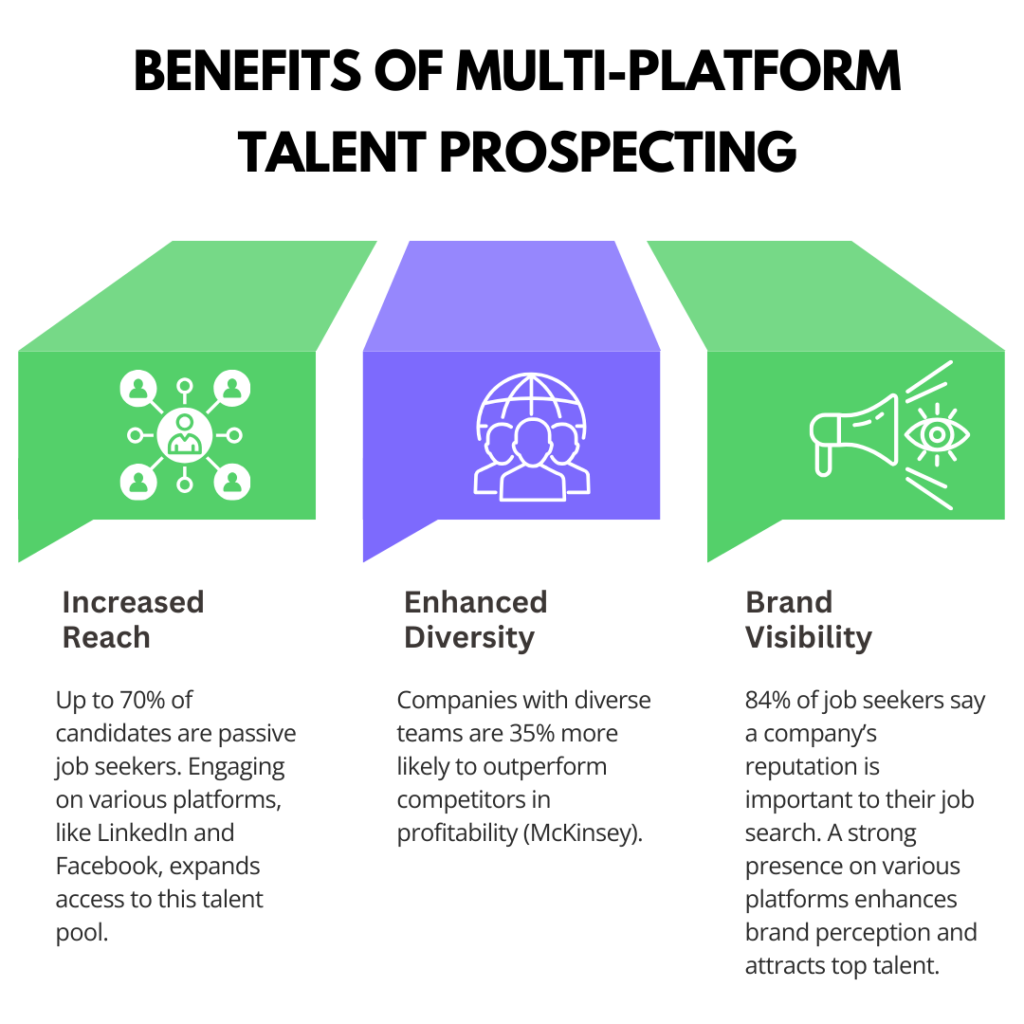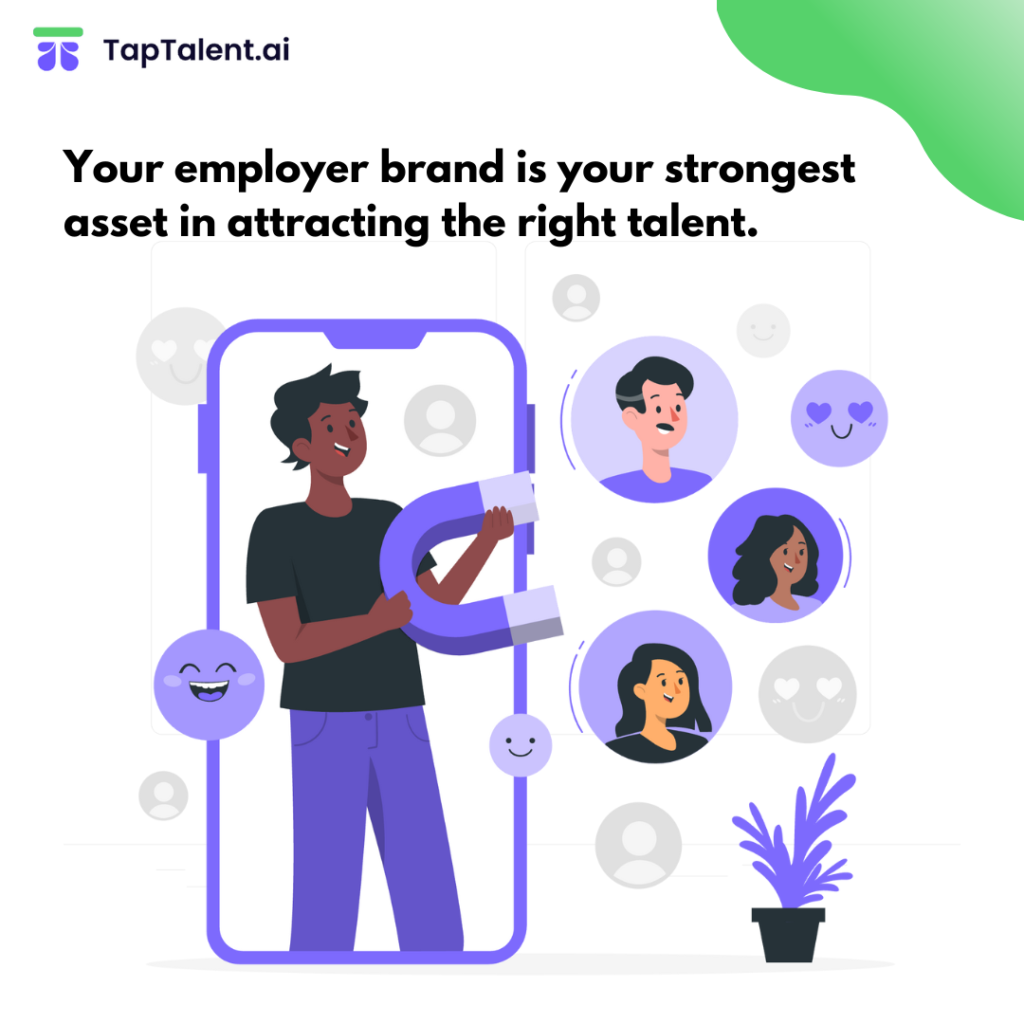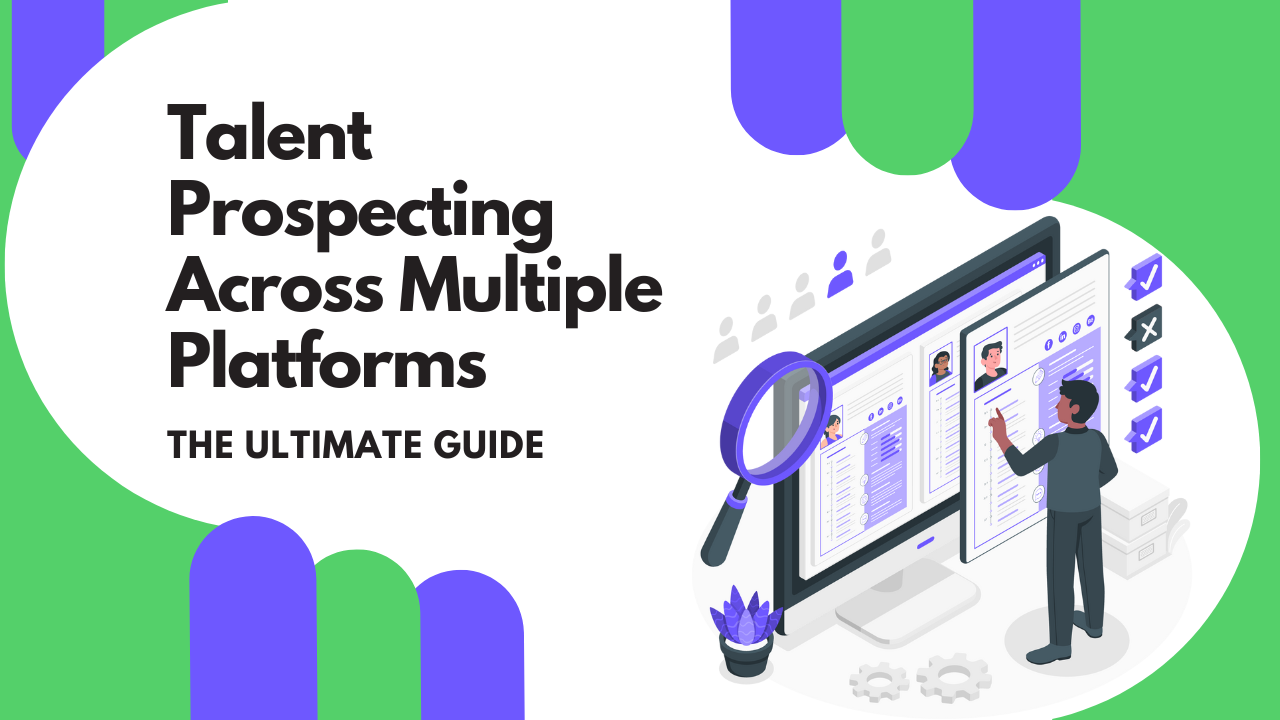Introduction
Recruiting in today’s competitive job market demands a versatile, cross-platform approach. Long gone are the days when posting a job on a single platform was enough to attract quality candidates. Today, reaching top talent requires casting a net across multiple platforms, each with its unique audience and set of engagement tools. A diverse, multi-platform strategy can significantly widen the talent pool, targeting both active and passive candidates. This blog explores effective strategies for talent prospecting across various platforms—from social media to niche job boards and AI-driven tools—to help recruiters engage the best talent.
In this guide, recruiters and talent acquisition professionals will find actionable insights on expanding their sourcing methods, building a strong brand presence on each platform, and ultimately increasing their chances of connecting with the right candidates.

The Importance of Multi-Platform Talent Prospecting
The Changing Recruitment Landscape
The recruitment landscape is evolving rapidly, driven by shifts in candidate behavior and technological advancements. Candidates now have countless ways to connect with potential employers, including professional networking sites, social media, freelance platforms, and industry-specific job boards. Many top candidates are found on multiple platforms, with passive candidates—those not actively searching for jobs—often residing on social media sites rather than traditional job boards.
Multi-platform recruitment helps recruiters engage with this elusive talent by going beyond conventional sources. LinkedIn, for instance, remains a popular platform for professionals, but recruiters are also successfully tapping into other networks like GitHub, Dribbble, and even Instagram to reach candidates in niche fields like tech, design, and creative roles. By diversifying recruiting channels, companies expand their reach and increase the likelihood of finding candidates who not only meet role requirements but align with company culture.

Benefits of Multi-Platform Recruiting
Adopting a multi-platform strategy for talent prospecting brings a host of benefits:
-
- Broader Talent Pool: Each platform reaches unique candidate segments, enabling recruiters to target a diverse set of skills and backgrounds.
-
- Enhanced Employer Branding: Leveraging multiple platforms helps build brand recognition and visibility. For example, sharing company culture on Instagram can attract younger, creative candidates, while a strong LinkedIn presence appeals to more experienced professionals.
-
- Access to Passive Candidates: Social media platforms, especially LinkedIn, offer ways to connect with passive candidates who aren’t actively searching but may be open to the right opportunity.
-
- Increased Candidate Quality and Diversity: By recruiting across platforms, companies reach a mix of candidates, helping to reduce hiring biases and boost diversity in the workforce.
Best Practices for Talent Prospecting on Social Media
Social media platforms have become indispensable in modern recruiting. They not only expand a recruiter’s reach but also offer innovative ways to engage candidates who may not be actively job hunting. By leveraging each platform’s strengths, recruiters can tailor their approach to maximize engagement and attract top talent. Here are best practices for tapping into the most popular social media channels for talent prospecting:
LinkedIn: The Go-To Platform for Professional Talent
LinkedIn remains the most widely used social media platform for professional networking, making it essential for recruiters targeting experienced, skilled professionals. To make the most of LinkedIn for talent prospecting, consider these strategies:
-
- Optimize Profiles: An optimized LinkedIn profile is essential for both recruiters and the company page. This includes clear job titles, professional headshots, and a compelling summary that highlights your company’s unique values and culture. A well-optimized profile not only attracts candidates but also builds credibility for your brand.
-
- Leverage LinkedIn InMail: LinkedIn’s InMail is a powerful feature for direct outreach, enabling recruiters to bypass traditional emails and reach candidates directly on the platform. Personalized InMail messages can increase response rates, as they allow for tailored, one-on-one engagement.
-
- Use Advanced Search: LinkedIn’s advanced search filters let recruiters find candidates based on experience, skills, location, and even past employers. These tools streamline the process of finding specific talent pools, helping recruiters locate ideal candidates quickly.
Twitter and Facebook: Engaging Candidates Through Social Listening
While not as recruitment-focused as LinkedIn, Twitter and Facebook provide opportunities to engage passive candidates and enhance employer branding.
-
- Social Listening: Social listening is the practice of tracking mentions of your company or industry-related topics. Recruiters can use this to identify individuals who engage with industry conversations, are passionate about relevant topics, and may be open to new opportunities. For example, Twitter’s advanced search can help locate candidates discussing skills or topics relevant to open positions.
-
- Hashtag Usage: Twitter and Facebook hashtags, like #NowHiring or #TechJobs, can attract potential candidates when used in job postings or engagement posts. Hashtags help extend the reach of your posts, increasing visibility among job seekers and niche groups.
Instagram and TikTok: Connecting with Younger, Creative Audiences
For companies looking to engage Gen Z and younger Millennials, visual platforms like Instagram and TikTok are increasingly valuable. These platforms are particularly useful for industries that rely on creativity and innovation, such as design, marketing, and tech.
-
- Showcase Company Culture: Both platforms allow recruiters to share glimpses of the workplace, team events, and day-to-day activities. Showcasing the company culture can resonate with younger candidates who value transparency and a sense of belonging.
-
- Create Engaging Content: Instagram Stories, Reels, and TikTok videos offer interactive ways to reach potential candidates. A “Day in the Life” series, employee testimonials, or behind-the-scenes looks can attract candidates by giving them insight into your work environment.
By adapting recruitment efforts to fit the unique strengths of each platform, recruiters can reach a wider, more diverse talent pool. This approach not only optimizes the prospecting process but also helps companies connect with candidates in meaningful, engaging ways that stand out from traditional recruitment methods.
Niche Platforms for Specialized Talent
In certain industries, recruiting top talent requires focusing on platforms that cater specifically to niche skills. By targeting specialized platforms, recruiters can connect with candidates who possess in-demand expertise that might be challenging to find on general job boards. Here are some of the most effective niche platforms for sourcing specialized talent:
Industry-Specific Job Boards: Finding Experts in Specialized Fields
Industry-specific job boards allow recruiters to connect with professionals who already have a passion for their craft and the community. They are particularly useful in fields like tech, design, and engineering.
-
- GitHub for Tech Talent: GitHub is widely recognized in the tech industry as a hub for developers to showcase their work. Recruiters can explore open-source contributions, projects, and profiles to identify candidates with coding skills that align with job requirements. Reviewing candidate contributions on GitHub offers direct insight into coding skills and project experience.
-
- Dribbble for Designers: For design-focused roles, Dribbble allows recruiters to view portfolios and interact with designers directly. By browsing work samples and past projects, recruiters can identify potential candidates whose design styles fit their brand’s aesthetic and values.
-
- Stack Overflow for Developers: Stack Overflow’s community-driven platform is an excellent resource for sourcing experienced developers. Recruiters can view user contributions, including responses and coding solutions, which help gauge a candidate’s problem-solving skills and expertise in various programming languages.
Freelance Marketplaces: Sourcing Short-Term or Project-Based Talent
Freelance platforms offer a flexible solution for roles that may not require full-time employees. They are ideal for companies seeking to fulfill temporary, project-based, or contract roles. Here’s how to make the most of freelance marketplaces:
-
- Upwork: As one of the largest freelance platforms, Upwork provides access to professionals across multiple industries. Recruiters can find candidates for roles ranging from software development to graphic design and marketing. Upwork also offers filters and reviews, allowing recruiters to assess experience and previous project success before reaching out.
-
- Fiverr: Fiverr is well-suited for smaller projects or short-term tasks, such as graphic design, writing, or video editing. Recruiters can review candidate profiles, portfolios, and ratings to assess the quality of work. Fiverr can be a valuable resource for finding skilled candidates quickly for specific tasks.
Utilizing these niche platforms gives recruiters direct access to industry talent pools, saving time and increasing the chances of finding well-qualified candidates. Moreover, with industry-specific platforms and freelance marketplaces, recruiters can build a more robust talent pipeline while ensuring candidates have the skills necessary for specialized roles.
Traditional Job Boards and Their Role in Modern Recruitment
While new channels like social media and niche platforms have gained traction in recruitment, traditional job boards remain essential. These platforms, such as Indeed, Monster, and Glassdoor, provide a foundation for reaching a broad audience. Their established popularity and extensive reach make them ideal for generating high volumes of applications for general roles.
Maximizing Job Board Listings: Tips for Effective Job Postings
To stand out on traditional job boards, recruiters need to write engaging, clear, and informative job descriptions. Here are some strategies:
-
- Craft Compelling Titles and Descriptions: Use clear, specific job titles that accurately reflect the position. Within the description, highlight key responsibilities, required skills, and what makes the role unique to attract qualified candidates.
-
- Include a Snapshot of Company Culture: Job seekers today look for roles where they can thrive both professionally and culturally. Including insights into your company’s values, work environment, and benefits can encourage applicants who align with your organizational culture.
-
- Optimize for Search: Many job boards use algorithms to rank job postings based on relevance. By incorporating industry-specific keywords naturally into job descriptions, recruiters increase the likelihood of appearing in relevant candidate searches.
Tracking and Analyzing Job Board Performance
Job boards also offer robust analytics for tracking recruitment efforts. Using these insights helps refine strategies and maximize recruitment ROI. Key metrics include:
-
- Application Rates: By tracking how many candidates apply through each job board, recruiters can assess which platforms are most effective. This data can guide future investment in high-performing boards.
-
- Cost per Hire: Calculating the cost per hire for each platform helps companies optimize their budgets. Platforms yielding lower costs per hire are valuable for future recruitment.
-
- Candidate Quality and Retention: Evaluating the quality of candidates sourced through job boards involves assessing their longevity and success within the company. Tools like applicant tracking systems (ATS) simplify tracking by connecting candidate data with post-hire outcomes.
Staying Relevant with Evolving Job Board Trends
Traditional job boards continue to innovate with new features, such as:
-
- Sponsored Listings: Paid options allow recruiters to boost job postings for increased visibility and reach.
-
- Company Branding Pages: Many job boards offer branded company profiles where organizations can showcase their values, culture, and achievements to potential candidates.
While traditional job boards may not be as dynamic as social media, they are effective tools for reaching diverse candidates and generating a consistent flow of applications. Combining them with newer platforms allows companies to build a well-rounded recruitment strategy that reaches both active and passive job seekers.
Using AI and Automation Tools to Enhance Talent Prospecting
Incorporating AI and automation into talent prospecting is a game-changer for recruiters, transforming efficiency and accuracy in candidate sourcing. AI-powered tools streamline everything from initial candidate matching to follow-up communications, helping recruiters save time and focus on high-priority tasks.
AI-Powered Candidate Matching
AI-driven tools can instantly match candidates to job requirements, going beyond basic qualifications. By analyzing skills, experience, and even cultural fit, these tools provide a more nuanced shortlist of candidates. This approach:
-
- Boosts Precision: AI algorithms assess detailed criteria, so recruiters can filter out mismatched profiles early. This precise targeting helps reduce hiring costs and shortens time-to-fill.
-
- Reaches Passive Candidates: AI can proactively suggest candidates who aren’t actively searching but match the job requirements, broadening the talent pool significantly.
For example, TapTalent’s AI-powered matching tool uses predictive analytics to match candidates based on their likelihood of excelling in both job performance and company culture. This increases the chances of securing the right fit from the start.
Automating Outreach Campaigns
Once ideal candidates are identified, automation can simplify the outreach process. Automated email campaigns, follow-up reminders, and personalized messages keep candidates engaged without requiring constant manual input. Some effective ways to use automation in outreach include:
-
- Email Sequences: Set up automated email sequences that inform candidates about your company, available positions, and follow-up opportunities. This maintains interest, especially for passive candidates.
-
- Scheduling and Reminders: Automated scheduling tools help coordinate interview times and remind candidates of upcoming steps in the hiring process. This prevents potential drop-offs due to lack of follow-up.
With TapTalent’s outreach automation features, recruiters can schedule messages and follow-up prompts, ensuring consistent engagement across different platforms. This seamless communication keeps candidates engaged and fosters a positive impression of the company.
Leveraging Chatbots for Initial Screening
AI chatbots can handle initial candidate inquiries and screen applicants based on basic criteria, freeing up recruiters for more complex tasks. For example, a chatbot can ask questions about experience, skill levels, and availability, saving time by pre-screening candidates. Chatbots also improve candidate experience by providing quick responses, enhancing the company’s appeal in competitive markets.
Using automation and AI in talent prospecting enables recruiters to streamline their processes and connect with high-quality candidates across platforms. This technology-driven approach empowers companies to meet hiring goals faster and with greater precision, enhancing both recruiter efficiency and candidate experience.
Building a Multi-Platform Candidate Relationship Strategy
To truly engage talent across multiple platforms, building a consistent, relationship-driven strategy is essential. When you reach candidates on different channels, it’s important to maintain a unified brand message while also personalizing interactions based on the platform and individual candidate preferences. Here’s how to create a winning multi-platform relationship strategy for talent prospecting.
Creating Consistent Messaging
A key element in multi-platform talent prospecting is maintaining brand consistency. Whether on LinkedIn, Twitter, or niche job boards, your messaging should reflect the same values, mission, and tone. Consistent branding reassures candidates that they’re engaging with a cohesive organization, reinforcing trust and interest.
-
- Define Core Values and Messaging: Establish a set of core messages that reflect your company’s culture and mission. Keep these elements clear and visible across all platforms.
-
- Adapt for Platform Tone: Each platform has its own tone and best practices. For instance, LinkedIn may require a more professional approach, while Instagram or Twitter can support a relaxed, visual showcase of your culture. Adapt messaging to fit platform norms without compromising your core brand identity.
Personalizing Candidate Outreach
Personalization is a powerful tool for increasing candidate engagement. By tailoring outreach messages based on the platform and candidate profile, recruiters can create meaningful connections that stand out. Personalization helps candidates feel seen, valued, and more inclined to respond.
-
- Use Data to Inform Messaging: Gather insights from candidate profiles and behaviors on each platform. For example, reference specific experiences listed on LinkedIn or respond to relevant posts on Twitter. Showing candidates that you’ve done your research reflects genuine interest and can build rapport.
-
- Platform-Specific Engagement: Customize how you engage based on each platform’s unique features. For instance, LinkedIn InMail allows for direct, formal communication, while Instagram stories or TikTok videos can offer a more dynamic glimpse into your work culture.
With TapTalent’s personalization tools, recruiters can easily customize outreach templates based on the candidate’s platform and background, making each interaction more impactful and relevant.
Nurturing Relationships Beyond the Application
Effective multi-platform talent prospecting doesn’t stop after the first interaction. Nurturing relationships over time helps to keep your company top-of-mind for candidates, even if they aren’t currently seeking a new role. This approach cultivates a pipeline of engaged, interested talent that you can draw upon for future opportunities.
-
- Create Follow-Up Touchpoints: Regularly re-engage candidates with personalized content, such as newsletters, updates on company achievements, or event invitations. Consistent touchpoints help to maintain interest and remind candidates why they were attracted to your brand in the first place.
-
- Encourage Community Building: Create a sense of community among potential candidates through social media groups, webinars, or virtual meet-and-greet events. Engaging candidates in this way helps them feel connected to your brand and allows them to learn more about your culture and team members.
Building a strong, consistent multi-platform relationship strategy in talent prospecting keeps your brand front and center, enhancing your ability to attract and retain the best talent over time.
Conclusion
In today’s fast-paced job market, effective talent prospecting is essential for success. By leveraging multiple platforms, recruiters can significantly enhance their reach, engage with passive candidates, and foster diversity within their teams. Implementing a multi-platform recruitment strategy not only increases brand visibility but also allows companies to adapt to changing candidate preferences. Remember, the landscape of recruitment is continually evolving, and staying ahead means embracing a variety of sourcing channels.
By exploring social media, niche platforms, and traditional job boards, you can tap into a wider talent pool. Moreover, utilizing AI tools can streamline your efforts, making it easier to connect with candidates who truly fit your organizational needs.
Ready to elevate your talent sourcing strategy? TapTalent offers powerful tools designed to help you prospect, engage, and hire the best talent across every major platform. Don’t miss out on the opportunity to transform your recruitment process—explore our features today and see how we can help you find the perfect candidates for your team!

Content
- Introduction
- The Importance of Multi-Platform Talent Prospecting
- Benefits of Multi-Platform Recruiting
- Best Practices for Talent Prospecting on Social Media
- Niche Platforms for Specialized Talent
- Traditional Job Boards and Their Role in Modern Recruitment
- Using AI and Automation Tools to Enhance Talent Prospecting
- Building a Multi-Platform Candidate Relationship Strategy
- Conclusion




